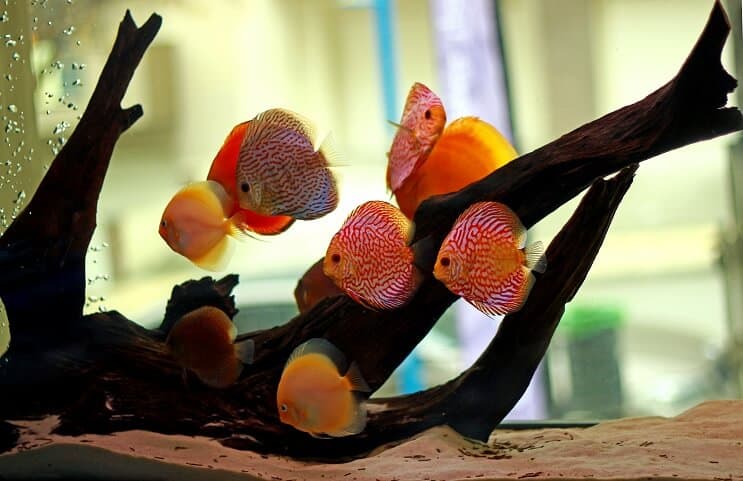
Since Discus require such high temperatures in home aquariums, some illnesses and parasites, such as Ich, do not afflict Discus as commonly as other fish. Their natural habitat also tends to have a great deal of wood in it, mainly from fallen trees and branches, so they do appreciate having large pieces of driftwood in their environment. Just know that you will see better colors and have a much better chance of breeding them in water conditions more to their liking. However, they can still thrive in water with a pH up to 7.6 and they will survive higher levels still. The good news for you is that this is no longer true! Captive-bred discus still prefer a lower pH. Since most tap water is very alkaline (high pH) and rich in minerals it made keeping discus very difficult for decades. They inhabit very soft and acidic water, which initially made them difficult to keep in the average aquarium.Īt first, they would only live in blackwater aquariums (water heavy in tannins) and water with a very low pH. The Discus Cichlid comes from the Amazon River in South America. While they do require large and frequent water changes, they do not handle changing decor or tanks very well and will become skittish until they settle back into their niche as the king of the aquarium. Lastly, remember that all discus crave stability. It takes discus some time to settle into a new aquarium.

That said, it is not unusual for them to act extremely skittish and hide in the corners of the tank for the first few days that they are introduced to their new home. But when your discus know they have cover nearby they will be bolder about remaining out in the open. Items like live plants and driftwood do make cleaning the tank difficult. Discus don’t need to disappear entirely but they do need something to hide behind. They also appreciate having plenty of hiding places. But six discus per home aquarium is a good minimum. In fact, they do better with even more companions. You may still experience the odd aggressive Discus, but this occurrence is very rare a nd usually directed towards each other and not their tank mates.ĭiscus are a schooling fish and need to be kept with at least five friends. Captive raised Colors and Patterns: Solid red discus, Albino platinum discus, Blue Discus, Pidgeon blood discus, and many moreĭespite being a cichlid, Discus are normally very timid and calm, which is the opposite of the aggressive nature that most cichlids display.Wild-Type Colors and Patterns: Green discus, Brown discus, Heckel discus.Origin: Amazon River Basin in South America.Scientific Name: Symphysodon aequifasciatus, S.Selective breeding also has not brought out bright colors in these other species.For now. The other two discus fish types are much rarer in the hobby and are favorites of specialists since they are just as sensitive as any other wild-caught discus fish. Current classifications list three species of discus but the majority in the hobby are all Symphysodon aequifasciatus : the Blue or Common Discus. There are three or two species, depending on which text you consult. Fortunately, discus are very peaceful and non-destructive towards plants and decorations. But sometimes other cichlids have too much personality and cause problems with their tank mates and aquarium decorations. Just like other cichlids, Discus are extremely intelligent and personable. The term “Discus” came about due to the flat, circular “disk” shape of this fish. 8.3 What is the Minimum Tank Size for Discus Fish?.



8 More Frequently Asked Questions about Discus Fish.2.1 Are Discus Fish Sensitive to Ammonia?.


 0 kommentar(er)
0 kommentar(er)
